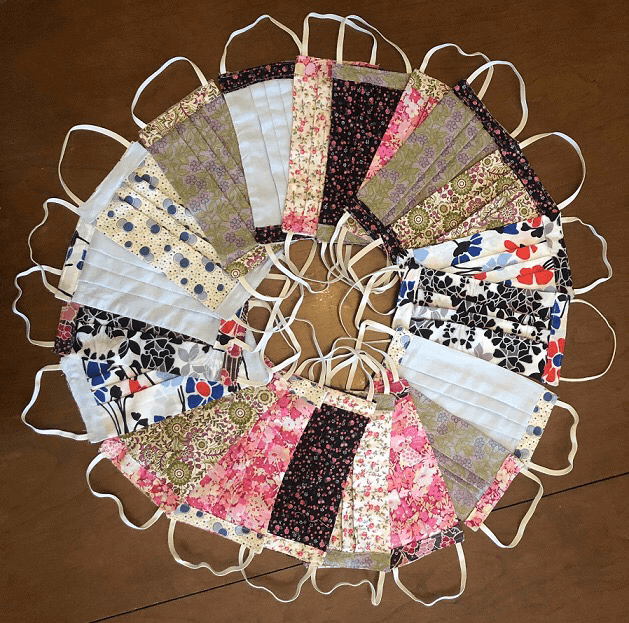8 Clever Facial Covering Hacks
Early in the pandemic, public health officials urged health Americans not to wear masks. Save them for people who work in health care settings and for people who have COVID-19 symptoms and must go out to seek care, they said. My, how things have changed. Welcome to April 2020, the month of masks.
This morning, President Trump announced that officials are working on guidelines urging Americans to wear facial coverings when not at home. Masks should be a supplement to social distancing, not a substitute, urges Dr. Anthony Fauci.
One big reason for the big shift on mask policy? Scientists are learning that many as one-quarter of Americans who have the virus have no symptoms, CDC director Dr. Robert Redfield said earlier this week. Masks may help reduce the risk of asymptomatic transmission among essential workers or people who must be out on essential errands.
Masks don’t protect you much from others’ germs, but they help you keep your germs to yourself. If everyone takes steps to keep their germs to themselves over and above social distancing measures already in place, we’re that much closer to flattening the curve. Masks may reduce virus transmission by 10 percent, which could do much to slow the spread. (To read up on the science behind this theory, check out this excellent explainer from Vox.)
There are few manufactured masks available, however. And, while it looks pretty badass, simply tying a bandanna around your face ‘Wild West bandit style’ isn’t enough. Why? Because when you speak, cough, or sneeze, heavy moisture droplets can fall through the opening and onto surfaces.
Off-the-shelf masks will be in short supply for a while. Gaiters and scarves from companies like Bioscarf are available, but as you await shipments or work to get your whole family outfitted, we’ve gathered the best materials, patterns, and hacks for your easy reference.
Best Material To Use for Making Masks
Though women all over the country are raiding their sewing scraps, cotton fabric and other woven materials aren’t the best mask materials on their own, research shows. If you’re using woven materials for fashion’s sake, you should line them in non-woven materials.
Got clean shop towels around? Informal tests show that non-woven materials filter particulate matter much better than ordinary fabric, according to this recent Business Insider article. Experts agree. “Peter Tsai, the materials scientist who invented the electrostatic charging technology that N95 masks — the highest-quality medical masks on the market — rely on, also believes that homemade masks are an important part of the United States’ battle against the coronavirus,” the Washington Post reported earlier this week. He offered another material for DIY mask makers to consider: nonwoven fabrics” like shop towels.
Check out this video tutorial for a no-sew shop towel mask:
Do not use regular paper towels or wet wipes as mask materials, experts advise. They won’t do the filtering job you need. Material cut from vacuum bags may do an excellent filtering job, but they’re difficult to breathe through. Shop towels are a non-woven material that strikes a nice balance between breathability and filtration.
What To Use Instead of Elastic
If your sewing kit is short on elastic, don’t expect to run down to the store and find some. Many fabric stores are closed because they aren’t considered essential businesses. Even if stores that usually carry elastic are open, they may well have been picked clean in your area. You can fashion fabric ties, which can actually help you create a better fit than elastic. If fabric ties are too involved for your taste, try hair elastics that you many have in your house. The loop is just the right size for a face mask.
Instructions for Sewing Masks
Earlier this week, Raina MacIntyre, an epidemiologist who has long studied the effectiveness of masks, outlined these criteria for masks for The Washington Post:
“Good coverage is important. The mask should reach above the bridge of the nose and below the chin. Fit is important. A mask should be snug. A fabric tie might work better than an elastic band. And if a mask is going to be reused, it must be kept clean. Layers add additional protection, so three-ply is good, as is including a small pocket or pouch, into which an additional filter can be inserted.”
The internet is littered with patterns for homemade masks. We’ve rounded up some of the best options for a crafty weekend ahead.
The New York Times is offering a free, downloadable and printable pattern (plus instructions) for this mask here.

This one comes with a YouTube tutorial from SarahMaker:

This one from Popular Science uses a material very similar to what surgical masks are made of—a material you likely have in your own home: reusable grocery bags. Just be sure to wash the material before you make the mask.

Finally, this one from Craft Passion includes free, downloadable templates not only for adults, but also for smaller, kid-sized faces. This design has a slot on the top, into which you can insert a “nose wire” for greater comfort. If you can’t find wire lying around the house, a paper covered plastic bag tie is the perfect length, a mask-making friend in Richmond, Virginia tells me.

Cleaning and Hygiene
Wash your masks every day that you use them, and hang them in the sunlight to dry. Sunlight kills germs.
It’s going to be difficult for many Americans to get used to wearing masks. We like to smile, to guffaw, and to give friends a peck on the cheek. But we’ll adapt. In many Asian cultures, where people are more accustomed to slowing pandemics, masks in public places are simply good etiquette. If masks help us beat the nasty bug, mask on.


